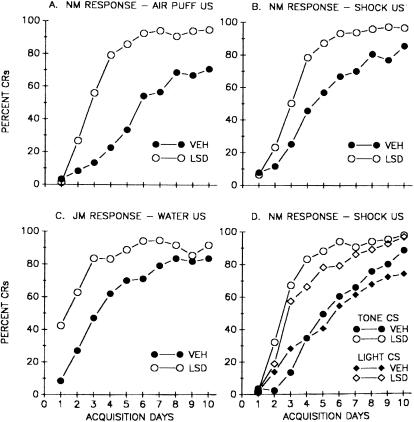Figure 1.
Enhancement of associative learning produced by the 5-HT2A agonist LSD under different experimental conditions. The ordinate presents the mean percent conditioned responses (CRs) during each of 10 conditioning days derived from a minimum of 10 animals per group. (A,B,C,D) The dose of LSD was 13 μg/kg (0.030 μmole/kg) administered intravenously into the marginal ear vein of the rabbit. Conditioning of the NM response was based on a delay procedure using an 800-msec CS, whose offset occurred simultaneously with the onset of a 100-msec unconditioned stimulus (US). (A) Acquisition of the conditioned nictitating membrane (NM) response (a component of the eyeblink) during tone CS and corneal airpuff US conditioning (Schindler et al. 1985a); (B) acquisition of the NM response during tone CS and paraorbital shock US conditioning (Gimpl et al. 1979); (C) Acquisition of the appetitive jaw movement (JM) response during pairings of tone CS and water US in water-deprived rabbits. Jaw movements are produced during the ingestion of water, and during conditioning, these movements begin to be initiated to the tone CS prior to water presentation (Gormezano et al. 1980); (D) acquisition of the NM response to tone or light CSs paired with a shock US. The intensity of the tone CS had been adjusted so as to support the same rate of conditioning as the light CS (Schindler et al. 1985b).

